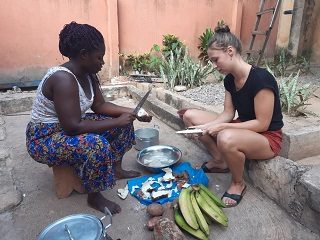When you only eat at restaurants while traveling in Ghana, you miss out on a lot. After all, food is a way to connect with locals. But what is sold on the streets, and what can you eat safely? Are there vegetarian or gluten-free options?
In this blog, I will summarize the most common street foods in Ghana. The list isn’t exhaustive—I could write a book about food here. Feel free to let me know in the comments if I missed your favorite dish!



What local street foods are sold in Ghana? Snacks (most are carried in glass display cases on vendors’ heads):
- Bofrot: A type of doughnut (vegetarian)
- Doughnut: A round fried ball, slightly different in taste from bofrot (vegetarian)
- Sweetpie: A crunchy version of doughnut (vegetarian)
- Meatpie: A savory pastry filled with meat, fish, or egg, sometimes fried or baked; not vegetarian
- Koose: A cake made from beans (gluten-free), typically sold by porridge vendors
- Kelewele: Spicy seasoned plantain chunks
- Bankye Krakro: Fried cassava and onion balls
- Spring rolls: Sometimes filled with fish, cabbage, or beans
- Fanice, FanYogo, FanChoco: Bagged ice creams
- Plantain chips, watermelon, bananas with peanuts



Various local drinks are sold on the streets of Ghana. A few examples include sobolo (a red-colored ginger drink made from hibiscus flowers), cold tea (chocolate milk served cold), Asaana (made from corn and caramelized sugar), and brukina (a drink made from milk and millet). Sobolo and Asaana are refreshing options for hot days, while cold tea is a sweet treat. Brukina is a nutritious drink.
Breakfast in Ghana
Rice porridge, oatmeal, and corn porridge are commonly sold at stalls in the morning, cooked without sugar and milk. You can add these when buying, making the porridge vegan-friendly. Unless you bring your own container, the porridge is often sold in plastic bags. Bread with an omelet and coffee, chocolate milk, or tea is a great breakfast option. You can order bread for around 5 Cedis, and they’ll cook the egg while you wait. Be mindful when ordering coffee or tea as it often contains a lot of sugar and milk.
Meals – rice dishes
- Rice with stew: Sold with various additions such as macaroni/spaghetti, salad, eggs, chicken, fish, or meat. Meat is often cooked with the stew, and shrimp-flavored Maggi cubes are used. This applies to all street-sold rice dishes.
- Jollof rice: Tomato-based rice served with chicken, eggs, meat, or fish and salad
- Fried rice with chicken: A variation of fried rice served with salad and shito sauce
- Waakye: A beans-and-rice dish served with stew and shito (pepper sauce with fish), optionally served with macaroni/spaghetti, meat, fish, eggs, salad, and gari (grated roasted cassava)

Bringing a container for street food purchases
Waakye is a beloved Ghanaian dish. I order mine without shito (often very spicy), with gari, spaghetti, salad, egg/fish, and avocado. As seen in the photo, plastic packaging is common in Ghana. In the past, natural materials like leaves were more frequently used for wrapping and serving food. Many are now advocating for a return to these eco-friendly materials. In the meantime, bringing your own container is a good alternative for travelers.
Meals – Ghanaian lunch and dinner
- Fried yam, plantain, or sweet potatoes: You can buy these by the piece, served with a pepper sauce, with optional chicken or fish. Yam has a taste similar to potatoes, while plantain is a type of cooking banana.
- Beans: Served with fried plantain, gari, sometimes fried onion, and stew
- Kenkey: Fermented maize dough balls wrapped in corn leaves. It has a slightly sour taste and is sold with pepper sauce, shito, and okra sauce, usually with fish. There is also a banana-leaf-wrapped kenkey variant, which is fermented longer.
- Boiled yam and plantain: Served with stew, fish, meat, or chicken
- Banku with peanut soup and meat or fish: Banku is a (lightly) sour dough ball made from maize and cassava meal
- Rice balls (omo tuo): Served with peanut soup, palm nut soup, or okra stew with meat or fish
- Indomie: Noodles with vegetables and eggs mixed in
Chopbars and local restaurants in Ghana
Many of the dishes listed above are also sold in chopbars and local restaurants, including fufu, one of the most popular dishes in Ghana. In northern Ghana, you’ll see more Tuo Zafi (TZ), made from cassava flour.

Vegetarian and vegan food in Ghana
If you don’t have access to your own kitchen or aren’t staying at a place like Moon & Star Guesthouse (where we’re familiar with dietary preferences and adaptable cooking), it can be difficult to eat vegetarian in Ghana. Vegan food is almost impossible to find, but not entirely. Here are some tips, because almost impossible isn’t totally impossible!
While vegetarianism isn’t widespread in Ghana, in cities like Kumasi and Accra, you can find a few vegetarian restaurants or shops. Larger supermarkets sell meat substitutes, too. Jennifer from The Ghana Traveller wrote a blog about vegetarian restaurants in Accra.
Vegetarian and vegan street food
Most street vendors think food is vegetarian if it doesn’t contain visible meat. However, many stews are cooked with meat or fish, and meat/fish-based bouillon cubes are often used.
- Fruit: Almost always available throughout Ghana, but be cautious about eating too much mango, as it can affect digestion.
- Fried yam/plantain: Note that fish is often fried in the same oil.
- Koose: A delicious and healthy vegan bean snack
- Some spring rolls are vegan: Ask the vendor if they are filled with beans.
- Rice and waakye: Buy these without the stew if you are strict about avoiding non-vegan ingredients. You could find (vegan) ketchup or other sauces in the city or add raw veggies or salad.
- Fried rice without the meat and shito sauce: Note that fried rice often contains eggs.
- Beans: You could buy beans from one vendor and add them to the rice bought from another.
- Kenkey: Without the shito or okra sauce, you can just order the pepper.
- Gari: Mix it with plant-based milk (powder), water, sugar, or fruit.
Gluten-free eating in Ghana: breakfast, lunch, and dinner tips
- Gluten-free breakfast: Try corn porridge (koko), rice porridge, or koose (fried bean patties). Boiled eggs are also gluten-free, but be cautious with the spicy sauce. For a simple gluten-free breakfast, you can buy gari (cassava granules), which you mix with sugar, powdered milk, water, and optionally peanuts.
- Gluten-free lunch and dinner: Rice is always a safe choice: plain white rice, waakye (rice with beans), or fufu (cassava and cooking banana). Be cautious with sauces like shito and soup, as they often contain gluten in ingredients like Maggi cubes. Opt for sauces you know are safe or bring your own. Fried yam and plantain are also good options, but avoid the dark shito sauce.
Is street food safe to eat?
I’m the first to admit I’ve occasionally gotten sick from eating street food in Ghana. But I’ve also gotten sick from restaurant food in Ghana and Europe. Choosing not to eat from local street stalls means you miss out on a lot, in my opinion. Travel and getting to know a country is often deeply connected to the experience of meals.
A few years ago, local cooks frequently used “bad” water for cooking. But now, treated water (pure water) and salt are used to wash vegetables. A time-tested tip that still works is to check if many people are buying the food you’re craving.



Meal time at BWO Hostel
BWO Hostel is known for delicious meals in a beautiful setting. As you’ve read in this blog, we love good food. There’s nothing wrong with eating street food, but if you need a break, be sure to stop by! We serve both local and continental food, using as many local ingredients as possible. We’re happy to accommodate vegan, vegetarian, gluten-free, or lactose-free diets. This is what our guest Kirsten, who has celiac disease, had to say:
“When we stayed at the hostel, every meal was a delight. Patricia and her team were incredibly creative with the food, and each course was completely different, made with local ingredients. It was fantastic to enjoy the food without any worries, and every meal was delicious. We always looked forward to what the next meal would be :)”






0 Comments
Trackbacks/Pingbacks